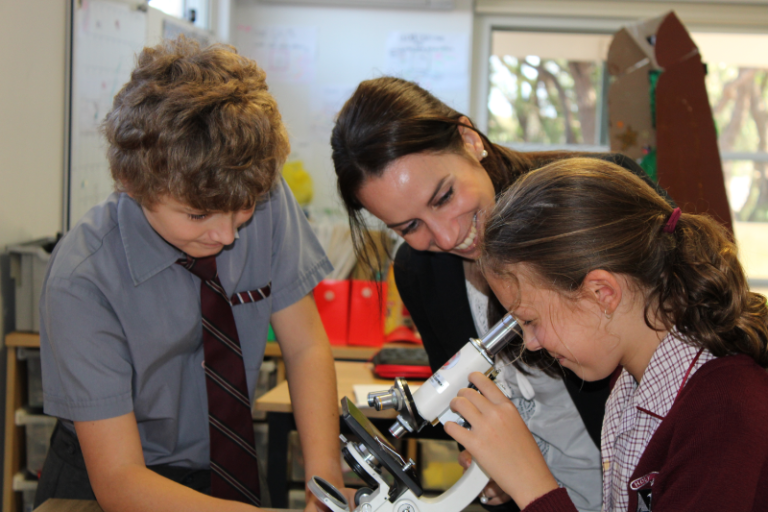The benefits of small schools far outweigh the challenges.
Choosing a school is one of the biggest decisions you make for your child. A reasonable fear many parents have is about the transition from the gentle world of home, to a large, busy schooling environment. After all, the average primary school is now catering for upward of 500 students.
Fortunately, there are other options. There are still small schools that are more conducive to individual care, while still achieving excellent academic outcomes. They are becoming rarer in numbers, but if you can access a small school for your child, you’ll find that in education, bigger is not better.
Small, single-stream schools are leading the way in more tailored and flexible learning programs. They also offer an environment that fosters empathy and positive wellbeing in a way that a large school never could.
1. Small schools are all about relationships and connection.
In a small school, children have a strong sense of connection. They mix with children from all year groups and learn to relate to people of all ages. They can make friends based on interests and maturity rather than being limited to those who are chronologically their peers.
Mr Steve Versteegen is principal at Holy Spirit Primary School, City Beach WA where they have 180 students. He says, “Our children enjoy strong rapport with not only their teacher, but all the staff at the school. There is shared concern for their learning and welfare.”
No child slips through the cracks. Their social, emotional and medical needs are known by all staff and the quirky little characteristics that make them special are appreciated.
Research tells us that belonging to close-knit communities is vitally important in developing a child’s resilience. It is also a protective factor against mental health issues and bullying. When kids have a feeling of belonging, they can breathe out and relax, and get on with the business of learning and thriving.
2. Small schools allow for close monitoring and tracking of learning development
Small classes offer students tailored instruction to meet their learning needs. The low student to teacher ratio means the teacher has time to ensure your child’s learning program is pitched at a level where they are challenged but feel safe and supported. That is the sweet spot we look for in education. It is where the magic happens.
Parent contact with the class teacher is easy in a small school. It is such a relief to be able to regularly communicate with educators who are closely tracking learning development. These teachers understand where the challenges lie, and those challenges can be addressed quickly. In a small school, ‘administrivia’ doesn’t get in the way and you don’t have to wait for large, impersonal parent nights.
3. Small schools allow flexibility in learning.
Mr Versteegen has been a principal in small schools for 39 years. He loves them. He says the fun part of a school like Holy Spirit is the flexibility they enjoy. With smaller numbers of students, hands-on learning is easy to organise and manage and the learning outcomes are great. There is much more freedom for collaborative student work and fun activities that bring learning to life.
Excursions can happen quickly and without fuss. Students at Holy Spirit have off-site excursions at least once a term. “It is easy to put the kids in our bus and share meaningful, real-life learning with them. It doesn’t have to be the logistical nightmare it can be in big schools.”
4. The staff in a small school are a unique asset
There is a special kind of teacher who is attracted to a small school. In order to work in such an interconnected and visible environment they must be confident, approachable and highly competent. There is nowhere to hide! The unprecedented work of Finnish researcher Pasi Sahlberg tells us this high teacher expertise has the greatest impact on learning outcomes.
Mr Versteegen says, “A small school allows the principal to hand-pick staff whose talents and skills specifically meet the needs of the children in the school.“ These teachers form a coherent team who work and develop together, they aren’t lost in a big staff.
The teachers who choose small schools love close communities and thrive on relationships. They are also more likely to stay with the school for an extended period of time. This means children are surrounded by adults who have known them for a long time and are invested in their wellbeing.
5. The partnership between parents and staff
It’s not just children and teachers who enjoy the benefits of small schools. Parents love the high level of partnership they experience. There is a real sense of community and ownership. Parent help is encouraged and welcomed. If a parent wants to have input into decision-making or want to speak with the principal, they can. In bigger schools, principals are becoming more like CEOs.
In small schools, parents are engaged and that engagement is channelled into great learning. For example, when solid research into play-based learning demonstrated its immense power, the Holy Spirit community responded by creating their own nature play area. Staff worked side-by-side with parents and students, wheelbarrows and shovels in
hand to build a custom-designed space. That’s the beauty of small, connected communities. They get things done.
Finally…
School aren’t just about academics. They are about the development of the whole child. Parents are looking for an education that fosters creativity, problem-solving, communication and good character. In this regard, the only real measuring stick is the quality of a school’s alumni.
Mr Versteegen says Holy Spirit is proud of its past students. “They enter high school academically prepared, equipped with leadership skills and self-assured. The fact they return to visit us often shows the sense of belonging they experienced here. It’s affirming for us as a small school. We’re getting things right.”
This article was first published by Holy Spirit Primary School, City Beach WA








